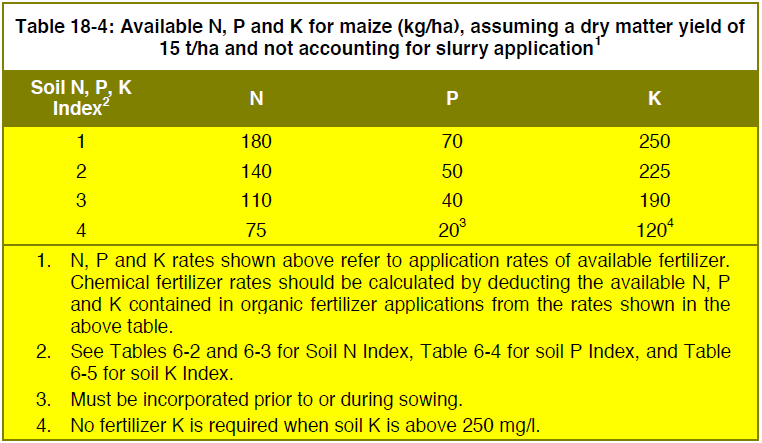
Teagasc Crop Report
Nutrient Guide for tillage Crops ( Teagasc Green book)
Nutrient Guide for tillage Crops ( Teagasc Green book)
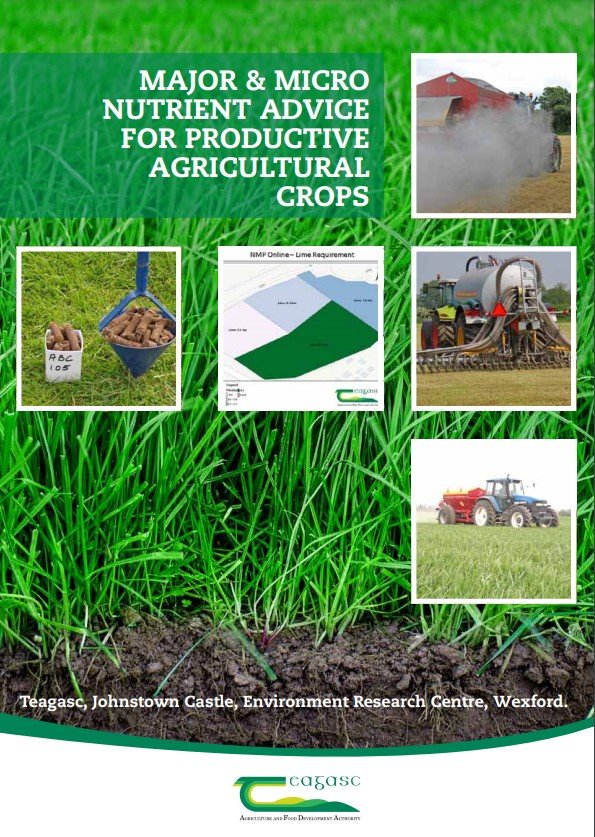
To view the full report you must have an existing account with Teagasc ConnectEd.
Farmers sign in hereAlready have a ConnectEd account? Connected Client or Teagasc staff log in here
Barley
(Extracts from the Teagasc Green Book of Major and Minor Nutrient Advice for productive agricultural crops )
Table 16-3 shows available N fertilizer rates for barley having moderate yields.
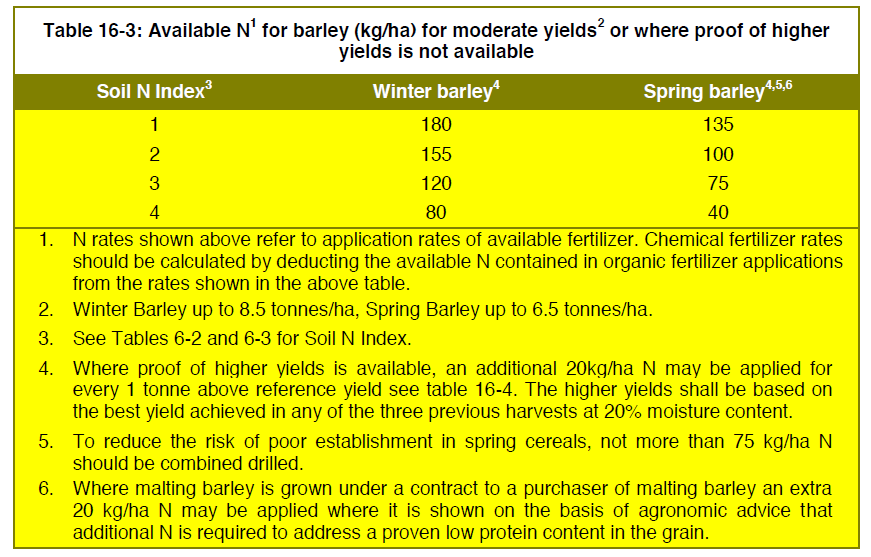
If proof of higher barley yields is available (as defined in the NAP regulations) then the available N rates from Table 16-4 may be used.
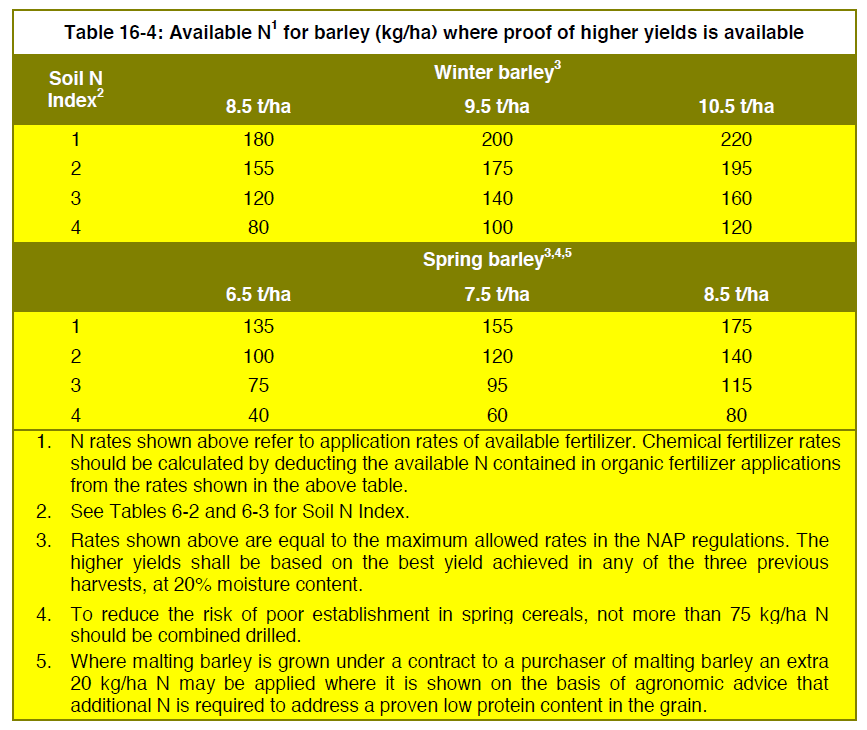
For N application strategies please click here for Winter Barely and Spring Barley
Oats
(Extracts from the Teagasc Green Book of Major and Minor Nutrient Advice for productive agricultural crops )
Nitrogen
Table 16-5 shows available N fertilizer rates for oats having moderate yields, as defined in the NAP regulations.
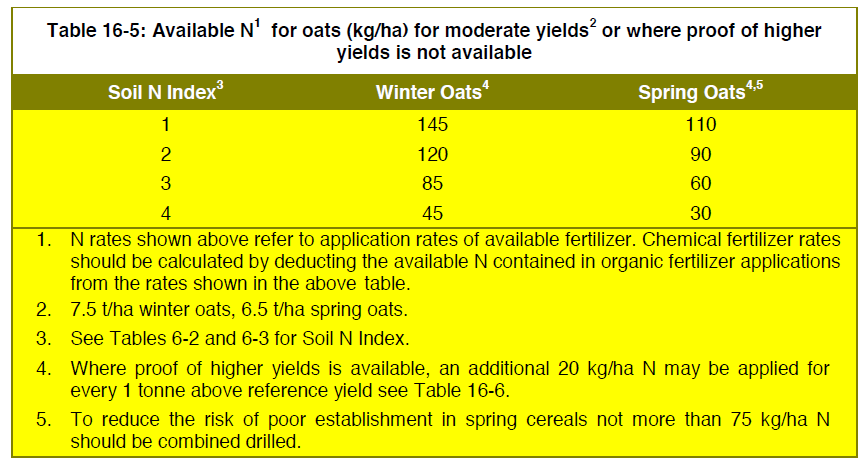
Table 16-6 shows available N fertilizer rates for oats where proof of higher yields (as per the NAP regulations) is available.
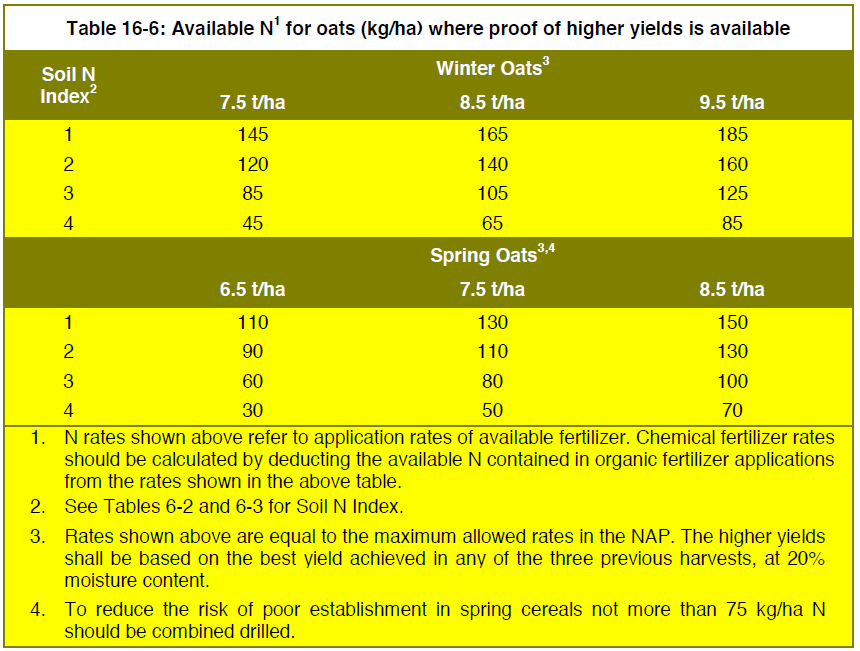
For Nitrogen application Strategies click here for Winter Oats and Spring Oats
Phosphorus and Potassium for Cereals
(Extracts from the Teagasc Green Book of Major and Minor Nutrient Advice for productive agricultural crops )
Advice for P and K is based on maintaining the soil test levels of these elements at the agronomic optimum level of Index 3. This is achieved by applying enough of the nutrient to replace the anticipated crop off-take, based on the expected yield of the crop to be fertilized. Where the Soil Index is below Index 3, build-up levels are required in addition to anticipated crop off-take in order to raise the Soil Index to Index 3. Regular soil p pests should be carriedout to ensure that soils are maintained within the agronomic optimum soil Index.
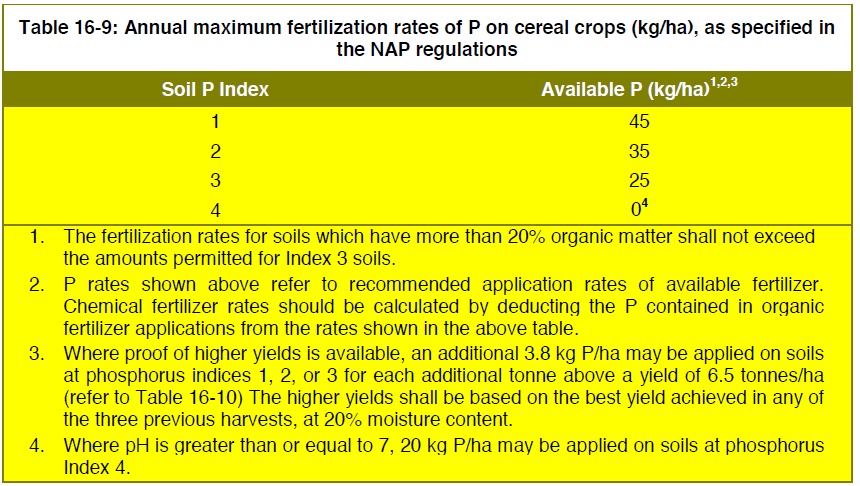
For spring sown cereals on low P soils (P Index 1 and 2) it is advisable that fertilizer P be incorporated at or before sowing. Research has shown a consistent benefit of placing P with the seed (combine drilling) for spring crops at Index 1 and 2 (Wall et al., 2013) soils. For winter wheat crops research has indicated no consistent yield benefit, even where soil P levels are very low, of autumn applied P, compared to broadcast applications in the spring.
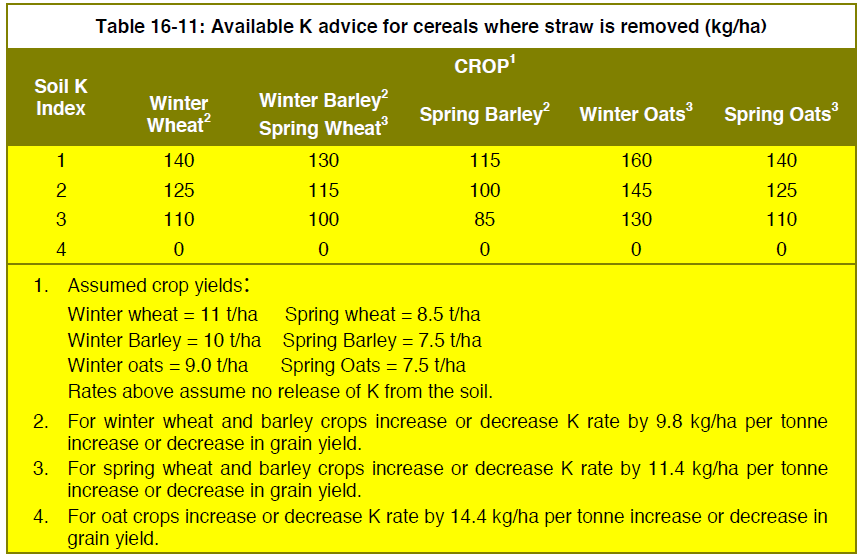
At soil K Index 1 it is advisable that at least a portion of the total K be incorporated at or before sowing. At soil K Indices 2-3, K can be incorporated prior to sowing or surface applied after sowing. If compounds are used, restricted periods for P fertilizer application as set out in the NAP must be observed.
P and K offtakes in cereal crops
Table 16-7 shows offtakes per tonne of grain yield of P and K by cereal crops. While grain yield is used to calculate offtakes provision is made in the values for offtake in the straw where applicable. Note that higher K offtakes are likely in straw that is less mature (i.e.slightly green).

Table 16-8 shows total P and K offtakes in high-yielding crops.
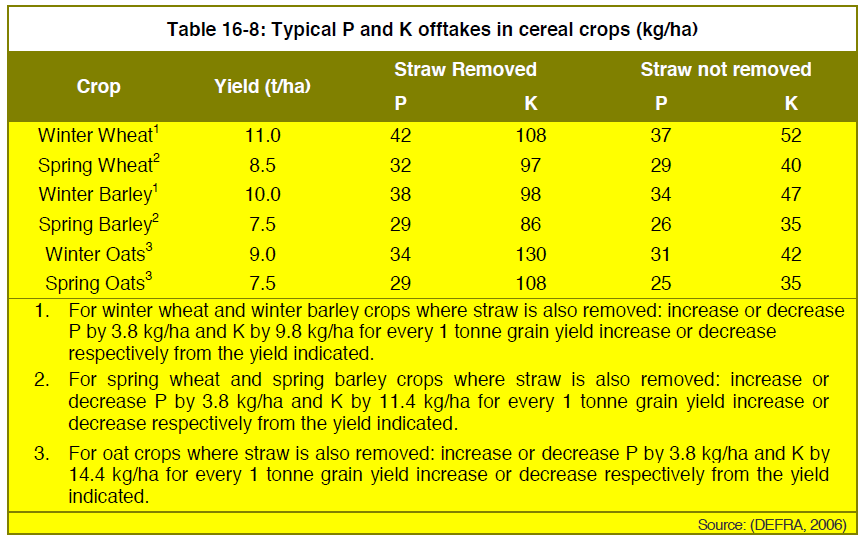
Potatoes
(Extracts from the Teagasc Green Book of Major and Minor Nutrient Advice for productive agricultural crops )
Nitrogen
Potato cultivars differ in their N requirement and there is no correct standard rate of N for all cultivars. Deep rooting varieties with very long haulm longevity such as Kerrs Pink and Markies are effective nitrogen scavengers and may require lower application rates in certain circumstances compared to those with medium or long haulm longevity. Varieties can be divided into four distinct groups according to the haulm longevity (Table 17-1).
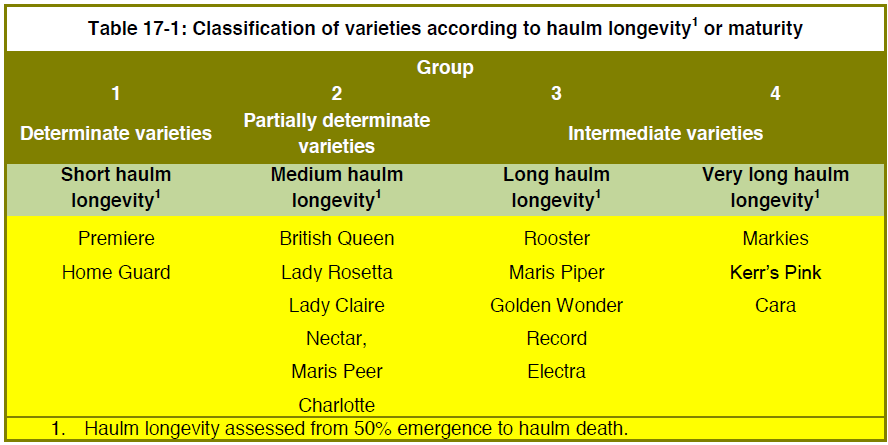
The main effect of N is to increase canopy size and prolong its duration. Yield increases from higher nitrogen rates will only result if harvest is delayed to take advantage of the extended canopy duration and consequent solar interception. However, this is more likely up to September as yield increases are small from mid-September onwards due to reduced solar radiation intensity. Also harvesting prior to canopy maturity may result in reduced dry matter/specific gravity and after cooking blackening in some cultivars. Where sowing date is delayed, nitrogen rates should be reduced accordingly. Thus, where tuber quality is important it is essential not to use high amounts of N in the event of a restricted growing season. The recommended available N rates are shown in Table 17-2. For most crops apply the nitrogen to the seedbed prior to planting. However, where the risks of leaching are high (light or shallow soils) a top dressing of no more than one third of the total can be considered but should be applied well before canopy closure. For early, second early and late maturing cultivars high N delays maturity therefore it is important to avoid over-use. The recommendations below take into account the length of growing period from planting to burn off. Where planting is delayed or early burn off is predicted to meet early market demands N use should be reduced accordingly.
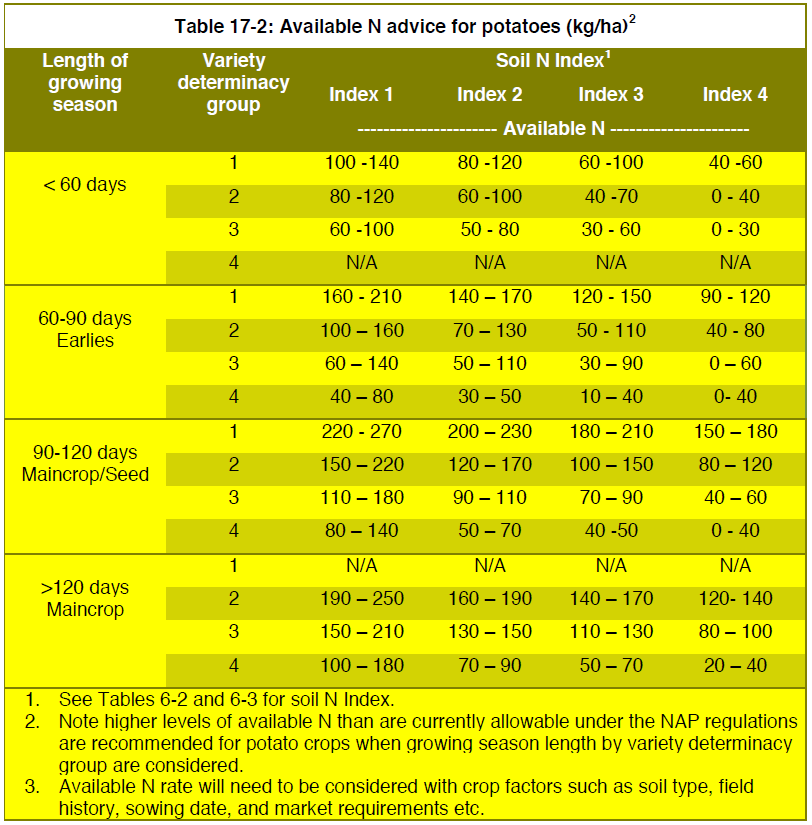
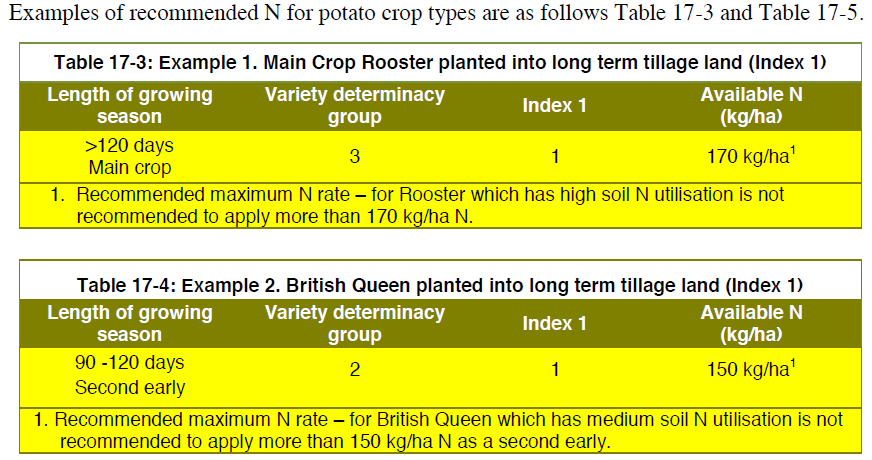
Salad potatoes are grown at higher seed densities, for smaller tuber sizes and for a very short growing season and hence require less N. Most salad potato varieties fall into haulm longevity group 1 or 2.
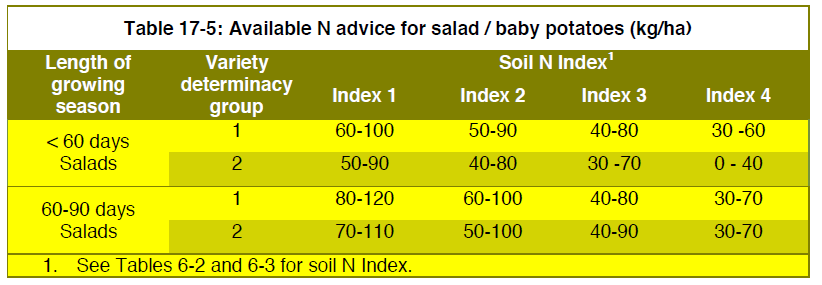
Maximum chemical fertilizer N and P allowed for potatoes in compliance with the NAP
regulations.
Maximum chemical fertilizer N and P rates allowed under the NAP regulations are shown in Table 17-7.
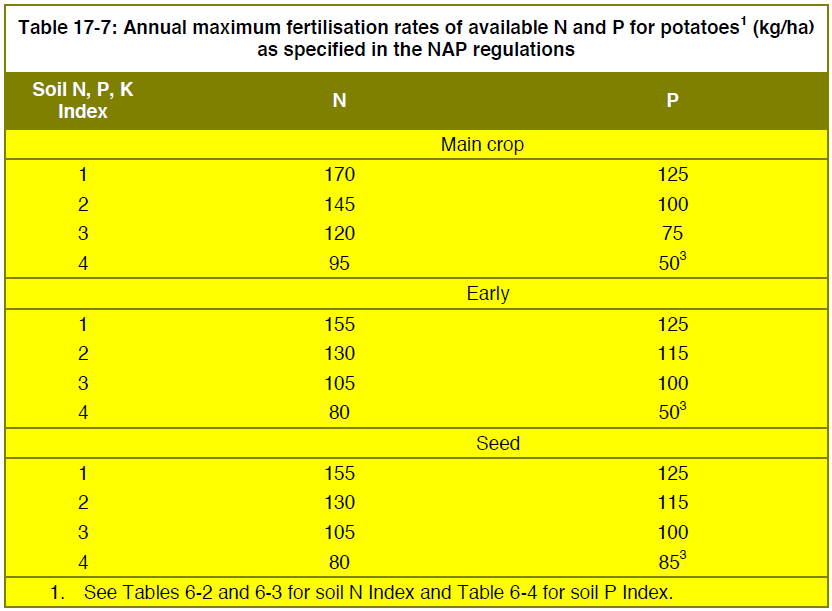
Phosphorus and Potassium
Potatoes are very responsive to P and K and it is necessary to apply these nutrients even at Index 4 (Table 17-6). All the P should be applied at sowing time but some of the K can be applied the previous autumn. Adequate supplies of available phosphorus are necessary to promote high tuber numbers per plant. Phosphorus will play an important part in the formation of tubers, especially for salad and seed crops where high tuber numbers are required to achieve economic marketable yield. Potassium regulates the amount of water in the plant, where there is insufficient potassium, crops will not use water efficiently. Potassium will also help the crops to withstand stress caused by drought, heat, waterlogging, etc. The use of potassium sulphate is associated with higher dry matter crops. Lower dry matter when using potassium chloride can result due to higher plant water caused by increased chloride supply. Excessive chloride uptake can also reduce starch content of the tubers. However, these potential effects of potassium chloride can be mitigated by using lower application rates or applying 6-8 weeks ahead of planting. The most efficient method of application of fertilizers to potatoes is by placing it in bands about 50 mm to the side and 50 mm below the level of the seed. Avoid high rates of placed potassium chloride as this can result in damage to the emerging sprouts. Apply the phosphorus and potassium to the seedbed and work into the soil prior to planting or placed at planting.
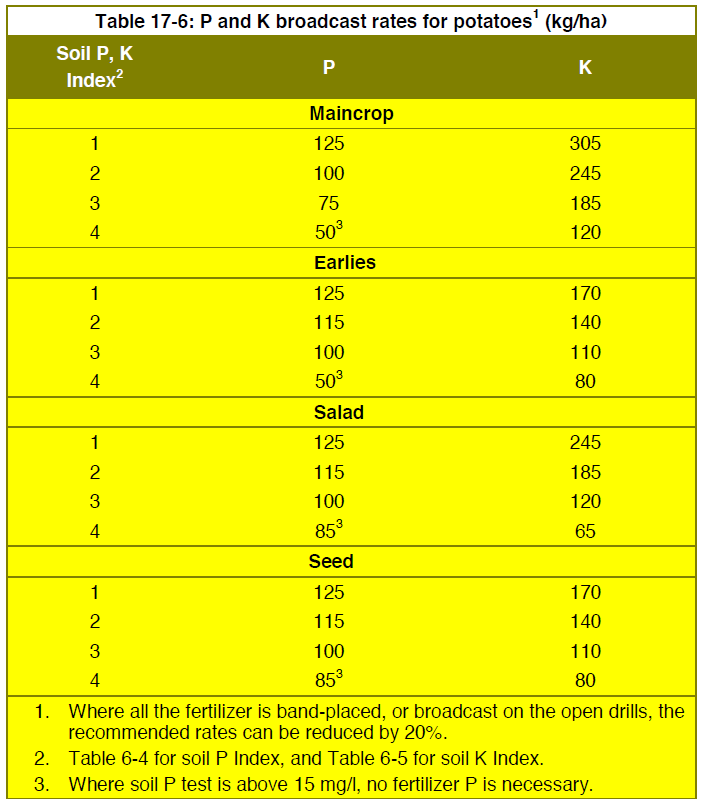
For more information on Potatoes click here
Fodder Beet
Nitrogen
(Extracts from the Teagasc Green Book of Major and Minor Nutrient Advice for productive agricultural crops )
N advice for fodder beet and sugar beet is shown in Table 17-8. Note that in higher summer rainfall areas, more N is required to achieve optimum yields. Nitrogen, phosphorus and potassium fertilizers should be applied during soil cultivations and worked in to the top 5 to 10cm of soil. Of the total N to be applied, it is recommended that 30 to 40 kg N/ha is applied at the 2 to 4 leaf stage of the beet crop.
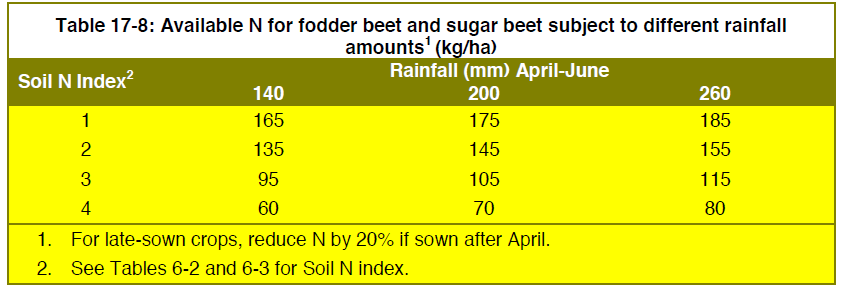
Phosphorus, Potassium, Sodium and Magnesium
The P, K and Mg nutrient and trace element advice for fodder beet are given in Table 1-9 and the accompanying footnotes. Although uptake of P by fodder beet and sugar beet is low compared with N and K, fertilizer P inputs are important because of high response by the beet crop. Table 17-9 relates to non-K fixing soils of average clay content with adjustments for K-fixing and clayey soils. Beet has a high K requirement, in common with other carbohydrate producing root crops. Although Na can substitute for K, it cannot completely replace the K requirement. There is no detrimental effect from using Na at levels found in beet compounds. Take account of the nutrient (N, P & K) inputs from organic manures (refer to chapter 9 organic manures) and adjust fertilizer advice in table 17-8 and 17-9 accordingly. Where the soil test for Mg is 50 mg/l or less (see Table 6-6), a response to Mg application is possible, although there is very little experimental evidence for such a response. Magnesium limestone should be used when lime is required on soils of Mg indices 1 or 2.
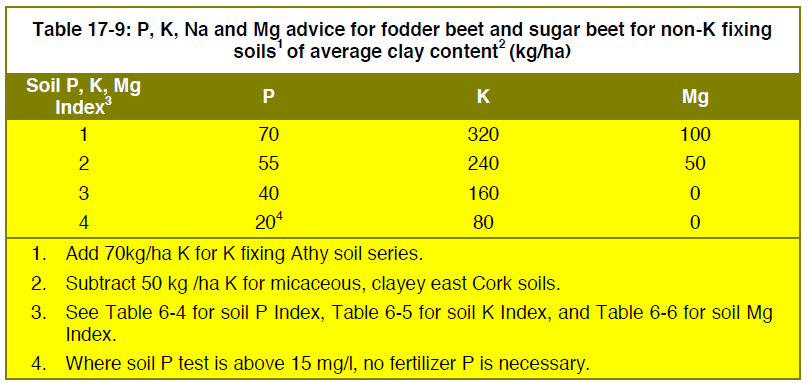
Boron
Boron leaches readily from all soils. This effect is severe in light sandy soils and less so in heavy soils but B application is generally necessary for all beet crops and especially for sugar beet. Boron uptake is severely restricted during periods of drought in all soil types. Thus, even when soil concentrations are above the critical level, B deficiency can still occur in sensitive crops. Where deficiency is likely to occur, a source of B may be included in the fertilizer to supply 3.0 kg/ha of B, referably applied to the seedbed. Where the soil test results (hot water extractable B) are less than 1 mg/l B, it may be worthwhile to supplement the soil application
with one or more foliar sprays. Foliar applications of boron should be made according to the product manufacturer’s recommendations which will normally be once there is sufficient ground cover for absorption, typically the 4-6 leaf stage. Repeat applications may be required where deficiency is severe.
Oil Seed Rape
Soil pH
The soil pH for oil seed rape should be above 6.5. Nitrogen management for winter oilseed rape For backward crops or crops grazed extensively by pigeons a light dressing (30kg N/ha) should be applied at the onset of spring growth (late Feb to early March), a third of the remainder should be applied 10 days later and the final dressing in early April. On moderate crops, one third of the N should be applied in mid -March with the rest
applied in early April. On large crops with lots of leaf area post winter, early N will encourage excessive vegetative growth and applications should be delayed with the first third of the total applied in late March/early April and the remainder applied as late as possible whilst still allowing a uniform spread pattern between the tramlines (before the crop gets too tall). This approach can be further refined by assessing the extent of green or leaf area development post winter using image analysis (mobile phone apps). A green area index (GAI) of 0.5 or less can be considered ‘backward’ or grazed. 0.5 to 1.5 would be normal, while anything in excess of 1.5 at the end of February would be considered large.
Nitrogen
For spring oilseed rape some nitrogen will normally be applied to the seedbed, but no more than 50 kg/ha N should be applied to reduce the risk of poor establishment. The remainder of the nitrogen will be applied between the two true leaf stage and the early stem extension stage.
Nitrogen, P and K advice for oil seed rape is shown in Table 18-1
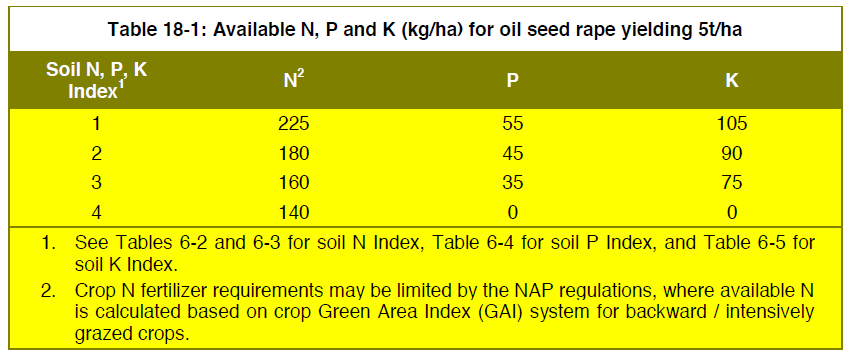
Sulphur
Oil seed rape responds to the application of S on most soils but particularly on those that are not frequently receiving organic manures are light or low in organic matter. Application of 20 to 30 kg/ha S will normally be adequate, with the higher rates being applied on lighter soils. The timing is not critical and Sulphur should be applied with the nitrogen.
Field Peas and Beans
(Extracts from the Teagasc Green Book of Major and Minor Nutrient Advice for productive agricultural crops )
pH
The optimum soil pH for field peas and beans is around 6.8.
Nitrogen
Nitrogen is not required for field peas or beans. Research at Oak Park has shown no benefit of nitrogen application at sowing.
Phosphorus and Potassium
Phosphorus and K advice for field peas and beans is given in Table 18-3. On low P soils(Index 1 and 2) combined drilling some P at sowing time with beans has shown to increase crop vigour, pod number and overall bean yield. If combine drilling P-K compounds care should be taken to keep K levels low (< 60 kg/ha) to avoid the risk of adversely affecting germination.
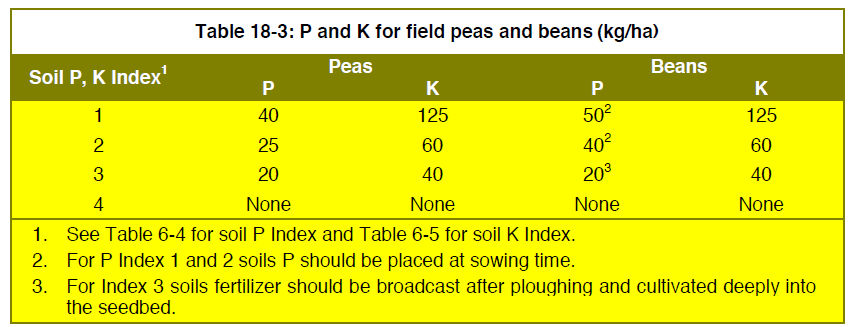
For more information click here for beans
Maize
Nitrogen
(Extracts from the Teagasc Green Book of Major and Minor Nutrient Advice for productive agricultural crops )
Getting the N supply correct is a critical and difficult aspect of the maize fertilizer programme. Applying too much N will delay crop maturity and is often more damaging than applying too little. Thus, the grower or advisor should consider the nutrient programme and N application rates very carefully. Nitrogen is made available from three sources; soil N, organic manures and applied fertilizer nitrogen.
The soil N index (Tables 6-2 and 6-3) should be used to adjust fertilizer N inputs for variation in soil N supply. Livestock manures are frequently used to fertilize maize crops. Livestock manures have the potential to supply all the N requirements of the crop, particularly where crops are grown in a grass rotation. An application of 33 t/ha of cattle slurry will provide from 25 to 30 kg/ha of N depending on the quality of the slurry and the time and method of application. To achieve the maximum benefit from nitrogen in livestock slurries they should be applied in spring and incorporated into the soil immediately after application. Recommended rates of total available N (available N in manures + fertilizer N) at each soil index are given in Table 18-4. The amount of fertilizer nitrogen required will be dependent on the soil N index and the amount of available N applied in livestock manures (see Table 9-3 to 9-5) i.e. the available N applied in livestock manures must be subtracted from the recommended amount in Table 18-4 to determine fertilizer N requirement. Nitrogen will normally be applied before sowing and incorporated into the soil. Placing a low amount of N near the seed (< 25 kg N/ha) at sowing can be beneficial. A portion of the fertilizer nitrogen can be retained and applied at the 5-7 leaf stage but leaf damage as a result of granule impact is likely which can adversely affect yield when high levels of leaf damage occur.
Phosphorus and potassium
Phosphorus and K advice for maize is also given in Table 18-4. An application of 33 t/ha of cattle slurry will provide 55 to 65% of the P and K needed at soil at Index 3 and above (i.e. soil levels at or above 6 mg/l P and 100 mg/l K). Apply the slurry in spring and plough in immediately to retain the N content. Maize can experience P deficiency during the establishment phase particularly when soil temperatures are low. Placing 20 kg/ha P near the seed at sowing to provide a supply of easily soluble P at the very critical establishment phase is likely to be beneficial where adverse soil conditions occur during the establishment phase. Maize has a relatively high requirement for potassium which should be applied prior to sowing and incorporated into the soil. Organic manures, particularly cattle slurry, can be used to supply a substantial proportion of K to the crop. It should be noted that offtakes of potassium by maize will also be high.
